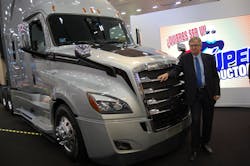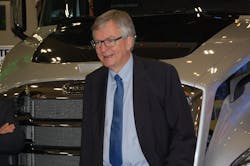So I recently listened to Martin Daum, member of the board of management at Germany’s Daimler AG and head of the company’s global Daimler Truck and Daimler Bus divisions, discuss the future of trucking during a press conference at the big Expo Transporte 2017 show in Guadalajara, Mexico.
[He was there to help support the addition of two new cabover models to the Freightliner ‘360 Family’ truck series sold here in Mexico; trucks Daimler builds in India based off a global platform.]
One of the interesting points he made – one well-known to anyone in the freight business – is that our economic systems today cannot function without trucks. There is just no other transportation tool – train, plane, automobile, etc. – that can do the work that trucks day in and day out.
“The world can live without passenger cars but it cannot live without trucks,” Daum said. “If you need to haul 80,000 lbs. of dirt, a wheelbarrow can’t do the job. You need something that can haul such heavy loads – and that is a truck.”
It’s a point I’ve made more than a few times myself: Trucks are a necessity. For example, the expectations for speedy delivery of goods ordered via the Internet – and to not pay an extra transportation fee for said delivery – is falling squarely on the shoulders of truckers and there’s little to no recognition of the vital role they play in making those deliveries happen each and every time.
Indeed, trucks currently haul over 70.6% of all the freight in the U.S. (though that is expected to slip to a hair over 67.2% by 2028) and haul over 80% of the freight in Mexico, according to Flavio Rivera, president and CEO of Daimler Trucks Mexico.
Thus, trucks are here to stay – whether they are loved or not for the job they do.
The question, though, is whether they must remain powered primarily by diesel and gasoline.
I talked to Mike Cammisa, vice president of safety policy connectivity, and technology for the American Trucking Associations (ATA), about that very subject at a recent press event in Washington D.C. and he’s of the opinion that we’ll start to see more powertrain “customization” in terms of fuel source in the future; a customization trend driven by the type of duty-cycle a truck must perform.
“What I see in the future is a diversity of powertrains and fuel sources; electricity is one of them and does seem appropriate in shorter haul applications, where the truck returns to a central depot and can be recharged overnight,” he explained to me.
“It makes sense to match the powertrain to the needs of the duty cycle and you can also combine systems, as well, such as in a hybrid powertrain that is part electric and part diesel,” Cammisa said. “Especially in inner city traffic situation, you could then run on electricity.”
Daimler’s Daum is of a similar mindset and believes one of the things truck OEMs must do in the future is to offer a “full range of options” when it comes to powertrains just as they do with cab interior packages and the like.
“Natural gas, propane and electricity are all options,” he said, pointing in particular to the new eCanter all-electric medium-duty truck built by Daimler subsidiary Mitsubishi Fuso.
Right now, Daum said the eCanter will only be sold on a “use case by use case” basis to customers around the globe, with limited production of the vehicle for the next two years. But by 2019, he expects the eCanter will be ready for “full throttle production” as he put it.
“It’s about on one side seeing what is possible and on the other knowing their limitations,” Daum said. “We know diesel is right now a necessity because it can haul higher loads. But we’re also showing that there is potential for an emission-free future.”
On a final note, he stressed that the improving economic picture for the U.S. and other countries is generating some positive trends for truckers. But Daum also cautioned that planning truck production levels correctly will be the real trick to ensuring such positives don’t turn into negatives.
“Times are not bad. That is a German euphemism for ‘good.’ And good times for the global economy always means good times for trucking,” he explained.
“But global instability is the salt in our soup of daily life; for the commercial vehicle market is a volatile market. We continually calculate how many trucks a country or regional will need based on its infrastructure, population, and economic development,” he added. “So if you sell too many trucks – more than the system needs – a crisis will come. But if you sell too few – such as in 2009, when we sold only half the trucks the economy needed -- then good times will be ahead.”
That’s one of many things to keep in mind as we barrel towards the close of 2017.
About the Author
Sean Kilcarr
Editor in Chief
Sean Kilcarr is a former longtime FleetOwner senior editor who wrote for the publication from 2000 to 2018. He served as editor-in-chief from 2017 to 2018.


